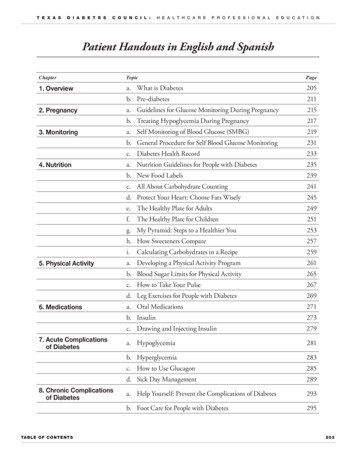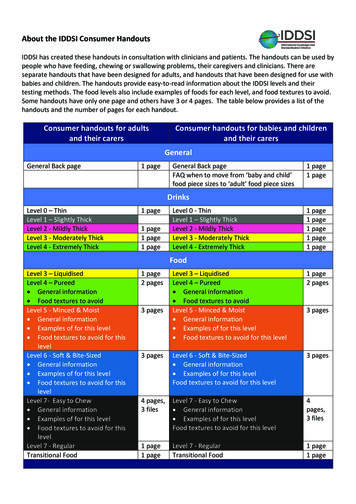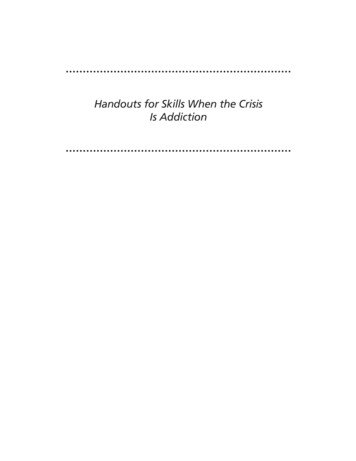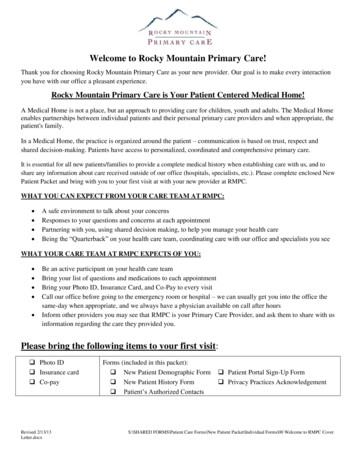
Transcription
T e x a sD i a b e t e sC o u n c i l :H e a l t h c a r eP r o f e s s i o n a lE d u c a t i o nPatient Handouts in English and SpanishChapterTopicPage1. Overviewa. What is Diabetes205b. Pre-diabetes211a. Guidelines for Glucose Monitoring During Pregnancy215b. Treating Hypoglycemia During Pregnancy217a. Self Monitoring of Blood Glucose (SMBG)219b. General Procedure for Self Blood Glucose Monitoring231c. Diabetes Health Record233a. Nutrition Guidelines for People with Diabetes235b. New Food Labels239c. All About Carbohydrate Counting241d. Protect Your Heart: Choose Fats Wisely245e. The Healthy Plate for Adults249f. The Healthy Plate for Children251g. My Pyramid: Steps to a Healthier You253h. How Sweeteners Compare257i.2592. Pregnancy3. Monitoring4. Nutrition5. Physical Activity6. Medications7. Acute Complicationsof Diabetes8. Chronic Complicationsof DiabetesTable of ContentsCalculating Carbohydrates in a Recipea. Developing a Physical Activity Program261b. Blood Sugar Limits for Physical Activity265c. How to Take Your Pulse267d. Leg Exercises for People with Diabetes269a. Oral Medications271b. Insulin273c. Drawing and Injecting Insulin279a. Hypoglycemia281b. Hyperglycemia283c. How to Use Glucagon285d. Sick Day Management289a. Help Yourself: Prevent the Complications of Diabetes293b. Foot Care for People with Diabetes295203
T e x a sD i a b e t e sC o u n c i l :H e a l t h c a r eP r o f e s s i o n a lE d u c a t i o nChapterTopicPage9. Hygienea. Skin Care and Diabetes297b. Foot Care Tips302c. Diabetes and Gum Disease306a. Diabetes and Stress Management308b. Coping with Diabetes312c. Changing Behavior314a. Travel and Diabetes318b. Diabetes and Disasters: Be Ready to Go!324c. Diabetes and Tobacco341d. Texas Quitline Fax Referral Form342e. Sharps Handling: Disposing of Needles and LancetDevices Safely344f. Free Diabetes Education Materials34810. Psychosocial Issues11. MiscellaneousTable of Contents204
PatientHandoutWhat is Diabetes?Diabetes is a serious chronic disease. It happens when too much glucose (sugar) stays in the bloodstream because there is either no insulin or not enough insulin that can move the sugar into the body’scells. Most of the food people eat is changed into simpler proteins, fats, or a simple carbohydratecalled glucose. Glucose is the form of “sugar” that cells need to make energy. The pancreas, a glandnear the stomach, normally makes insulin to move glucose from the blood stream into the cells. Indiabetes, the body cannot make or properly use the insulin it has.Controlling blood sugar helps to prevent the damage to blood vessels and nerves that lead tocomplications: blindness, amputations, kidney failure, stroke, heart attack, digestive and nerveproblems, gum disease, and depression. Good control is achieved by daily attention to nutrition,physical activity, weight control, monitoring blood glucose, and taking medicines as ordered. Regularcheckups (including blood tests, dental exams, eye exams, and foot exams) are recommended.T ypes of DiabetesThere are 2 major types of diabetes.1uT y p e d i a b e t e suIs usually diagnosed under the age of 20, but can occur at any age.uDoes not usually run in families, but there is a higher risk.uUsually occurs in normal-weight individuals.uAccounts for up to 10% of all diagnosed cases of diabetes.u2Typeud i a b e t e suWas called Insulin Dependent Diabetes (IDDM) or Juvenile Onsetuntil 1997.The body may produce normal, high or low amounts of insulin, but thebody is unable to use insulin properly.Is usually diagnosed in people over 30 years of age, but is being foundmore frequently in youth who are overweight.uTends to run in families; has a strong genetic risk.uBeing overweight and inactive raises this risk.uuuOverviewCauses the body to produce little or no insulin. The person with type 1diabetes must replace insulin daily. An auto-immune change damagespancreas beta cells.Increases the risk for heart attack and stroke due to high blood pressureand high cholesterol.Accounts for most (90%) of all diagnosed cases of diabetes.Was called Non-insulin Dependent Diabetes (NIDDM) or Adult Onsetuntil 1997.205
PatientHandoutWARNIN G SI G NS OF D IABE T ES1.2.3.4.5.Excessive thirst or hungerFrequent urinationExtreme weakness or fatigueInfections, cuts or sores that are slow to healBlurred vision6. Tingling or numbness of the feet or hands7. Frequent skin, dental (gum), urinary oryeast infections8. Impotence9. Feeling that you have “no energy”RIS K FA C T ORS f o r T y p e 2 D i a b e t e s1. Overweight — greater than or equal to 30 pounds overweight or a body mass index (BMI)greater than or equal to 25 (greater than or equal to 23 if Asian American)2. Family history of Diabetes Mellitus (DM)3. Hispanic/Latino, African American, American Indian, or Asian American heritage4. Over 30 years of age and overweight or over age 455. Delivered a large baby, 9 pounds or more, or had diabetes during pregnancy (gestationaldiabetes)6. Inactive lifestyle (exercise less than 3 times a week)7. High blood pressure (140/90 or higher)8. Abnormal cholesterol (lipid) levelsP REVEN T ION OF T y p e 2 D IABE T ES1. See your healthcare provider to check for diabetes, if you have two or more risk factors(as noted above).2. Try to be more active.a. Choose activities you enjoy doing, such as walking, dancing, gardening, or bicycling.b. Activity should be done regularly, for at least 30 minutes most days a week.3. Develop healthy eating habits.a. Reduce fats to no more than 30% of daily calories.b. Cook with nonstick sprays or vegetable oils (canola/olive). Eliminate lard and shortening.c. Use low-fat cooking methods such as broiling, baking, grilling, and steaming.d. Trim fat and skin from meats and poultry.e. Eat smaller portions. Use the Food Guide Pyramid for portion size.f. Choose foods high in fiber, such as fruits, raw vegetables, beans, peas, and whole grains.g. Eat well-balanced meals about the same time each day.4. Be alert for warning signs. Call your doctor if they occur.Overview206
PatientHandoutPre-diabetesAccording to The American Diabetes Association, before people develop type 2 diabetes, theyalmost always have “prediabetes.” People with pre-diabetes have higher than normal blood-sugarlevels but the levels are not high enough to have a diagnosis of diabetes. 100mg/dlZo, 140 mg/di::a::01J:ri': rFPGZ,oOGTTThere are two different tests your doctor can use to determine whether you have pre-diabetes: thefasting plasma glucose test (FPG) or the oral glucose tolerance test (OGTT). The blood glucoselevels measured after these tests determine whether you have a normal metabolism, or whether youhave pre-diabetes or diabetes. If your blood glucose level is abnormal following the FPG, you haveimpaired fasting glucose (IFG); if your blood glucose level is abnormal following the OGTT, youhave impaired glucose tolerance (IGT).Take the Diabetes Risk Test at: symptoms.jspWho should be tested for type 2 diabetes?Anyone age 45 years and older should ask about testing during an office visit.u Anyone who is overweight and 45 years or older should be tested.u Anyone who is overweight and who has other risk factors, even if under age 45 years(including children age 10 years and up), should ask the health care provider about testing.uTesting according to risks can help diagnose pre-diabetes earlier so you can start action to preventor delay developing type 2 diabetes. With type 2 diabetes, the pancreas can either no longer makeenough insulin that the body can use, or the insulin that is made is not used properly.Overview211
PatientHandoutWhat can you do about pre-diabetes?The good news is that people can lower their risk of developing type 2 diabetes with only a 5-7%weight loss. Being physically active most days and cutting excess calories in meals and snacks usuallyresults in weight loss.You can request your health care provider check your blood glucose during an office visit.When should your family talk about pre-diabetes and type 2 diabetes?As we get older, the chances of developing type 2 diabetes rise. Being overweight is a big risk, andother risk factors increase the chances, too. Some risks include:1) Having a close relative with type 2 diabetes2) Family background is African American, American Indian, Asian American,Hispanic/Latino, or Pacific Islander3) History of gestational diabetes (diabetes only during a pregnancy) or had a baby weighingmore than 9 pounds4) High blood pressure (140/90 or higher)5) Cholesterol levels not normal; HDL cholesterol is 40 or lower, or triglycerides level is150 or higher6) Being fairly inactive, which means exercising fewer than three times a weekWhat do I do about pre-diabetes?If you are overweight, start to lose some of the excess weight through daily physical activityand cutting excess calories (mainly fatty foods).u If you are inactive, start to add some physical activity more days.u If you have high blood pressure or high cholesterol, try to lose excess weight by beingphysically active and making smart food choices. Talk to your doctor about cutting downon salt and alcohol. Ask your doctor if you need medicines.uChapter Title212
PatientHandoutGuidelines for Glucose Monitoring During PregnancyRecommendations1. Check blood sugars at least upon awakening and one hour after meals.2. The doctor may also want you to check 1 or 2 hours after eatingand/or 3:30 a.m. Follow your doctor’s orders.Checking throughout the day will help to make sure that if the blood sugarlevel is too high or too low, it can be corrected quickly.Blood Glucose Goals during Pregnancy:Fasting:65-90 mg/dL1 hr after a meal: less than or equal to 140 mg/dL2 hrs after a meal: less than or equal to 120 mg/dLGuidelines for Ketone TestingRecommendations1. Test for ketones first thing in the morning (fasting).Call your doctor or health care provider if you have MODERATE TO LARGE KETONES.If your blood sugar is normal and you have moderate to large ketones, you may need more foodor calories before bedtime. Be sure your doctor or health care provider is notified.2. Test for ketones when your blood sugar is greater than 140 (some doctors prefer greater than200) or when you are ill. Call your doctor or health care provider if you have MODERATE TOLARGE KETONES.If your blood sugar is high and you have moderate to large ketones, this may indicate that youneed more insulin or may need to be placed on insulin.3. CALL YOUR DOCTORIf your results are frequently above your target range orIf blood sugars are always greater than 140 mg/dL and/orYou have moderate to large ketones orYou have signs and symptoms of hypoglycemia more than twice in one week.P r e g n a n cy a n d D i a b e t e s215
PatientHandoutTreating Hypoglycemia During PregnancySigns and Symptoms of Hypoglycemia — Low Blood SugarShaky Cold sweatHeadache DizzinessIrritability DrowsinessDifficulty talking Blurred visionIf possible, check blood sugar and treat immediately!If you are feeling really bad and are sweating a lot, you may take your treatment first, and then checkyour blood sugar.If you have hypoglycemia (low blood sugar) you must begin treatment immediately.If your blood sugar is 50-70 mg/dL1. Drink one 8-oz. glass of low fat milk or chew 2-3 glucose tablets.2. Wait 15 minutes and test blood sugar again.3. If your blood sugar is still less than 70 mg/dL, drink a second glass of milk or chew moreglucose tablets to reach your desired goals.(Note: One glucose tablet will increase your blood sugar by about 20 points.)4. Wait 15 minutes and test blood sugar again.5. If your blood sugar is still less than 70 mg/dL, eat a slice of bread and drink a third glass ofmilk, or chew more glucose tablets. (Repeat the treatment.)If your blood sugar is less than 50 mg/dL1.2.3.4.Drink 1/2 cup of orange or apple juice or 1/3 cup of grape juice or chew 2-3 glucose tablets.Wait 15 minutes and test blood sugar again.If blood sugar has not risen by 20 points, repeat the treatment.Continue to take a simple glucose, such as juice or glucose tablets, until your blood sugar isabove 70 mg/dL.5. If it is going to be more than 1 hour before your next meal, eata. a complex carbohydrate, such as a piece of bread or 6 crackers PLUSb. a protein, such as 2-3 oz. of cheese, sliced ham or chicken, or 2 tbsp. of peanut butter.P r e g n a n cy a n d D i a b e t e s217
PatientHandoutSelf Monitoring of Blood Glucose (SMBG)It is extremely important to monitor your diabetes at home on a daily basis. This involves bloodsugar testing and blood/urine ketone testing when sick or if blood sugar levels are high.Testing your blood sugar can help you control your diabetes. It is important that every person withdiabetes have a blood glucose meter and know how to use it.Knowing when and how often to monitor is very important. Your results will help you and yourhealth care provider decide whether changes need to be made regarding your meal plan, activity,and treatment plan.When to test:Listed below are times that you may be asked by your health care provider to monitor your bloodsugar:1. Fasting (first thing in the morning — usually 8 hours without eating/drinking anythingbut water)2. Before meals3. 1-2 hours after meals (from first bite)4. At bedtime5. At 3:00 a.m.How often to test:Your diabetes health care provider will recommend how often you should test your sugar level.Testing times are based on the kind of medicine you take and on how well your sugar levels arecontrolled.Common frequencies are listed below:Monitor your blood sugar 3-4 times per dayuIf you have type 1 diabetes and are taking insulinuIf you have type 2 diabetes and are taking insulin and diabetes pillsMonitor your blood sugar 2-3 times per dayuIf you are taking diabetes pills only and have not achieved your target A1cAsk your health care provider how often you should testuM ONI T ORIN GIf you are taking diabetes pills only or you are controlling your diabetes withnutrition and physical activity alone219
PatientHandoutYou should increase the frequency of testing in the 2-3 weeks prior to your health care professionalvisit. The more information you provide, the better your health care provider can direct your careand management.Occasionally, you may need to check more often in order to decide how your medication andtreatment plan is working. Your health care provider may ask you to monitor several times throughoutthe day and possibly at 3:00 a.m.Blood Sugar GoalsAmerican Diabetes Association(2008)American College of EndocrinologyPre-meal blood sugar70-130 mg/dLless than 110 mg/dLPost-meal blood sugarless than 180 mg/dLless than 140 mg/dLA1cless than 7%*less than or equal to 6.5%*Although less than 7% is the A1c goal, the A1c goal for the individual patient is an A1c as close tonormal (less than 6%) as possible without significant hypoglycemia.What does SMBG at the recommended times tell me?Time of TestCan be used to .Fasting blood sugar (FBS)Night time blood sugar (3-4 a.m.)Adjust oral medications or long acting insulinBefore a meal1-2 hours after beginning a meal(post-prandial)At bedtimeAdjust the type of food to eat or adjust beforemeal insulin.Learn how food affects sugar values(Often the highest blood sugar of the day)Adjust meal plan or medicationsReasons to check your blood glucose (sugar) more frequently:uIf your diabetes medicine changesuIf you begin taking other kinds of medicinesuIf you change your meal planuIf your exercise routine or activity level changesuIf your level of stress increasesuM ONI T ORIN GIf you are sick. When you are sick, even without eating, your blood sugar levels may runhigh, so testing is important!220
PatientHandoutOther reasons to check your blood glucose (sugar):uuuuuIf you have symptoms of low blood sugar (hypoglycemia), such as dizziness, shaking,sweating, chills, and confusionIf you have symptoms of high blood sugar (hyperglycemia), which include sleepiness,blurred vision, frequent urination, and excessive thirstTo see how meals, physical activity, and medicine affect your blood sugar levelTo document how well your blood sugar is controlled if you have a job in which poorcontrol could cause safety problemsTo help you decide if it is safe to drive or perform other tasks that require concentrationWhen you are ill or not feeling well:You will need to test blood sugar more often and may need to test ketones as well. (See Sick Day Rules.)1. Test your blood sugar every 2-4 hours (or as medically advised) until stable and you arefeeling better.2. If you have type 1 diabetes:u Test for ketones in your urine when you are ill or not feeling well.u Test for ketones whenever your blood sugar is greater than 240 mg/dL.3. Rest and get plenty of fluids (water or sugar-free beverages)Be cautious of “sport-ade” types of drinks. Be sure and read the nutrition facts label to properlyevaluate the amount of carbohydrates per servingCall your health care provider if:1. Your blood sugar is greater than 240 mg/dL for more than two days.2. Your blood sugar is less than 70 mg/dL more than twice a week.3. If you have moderate to large ketones in your urine (measured with urine ketostix or bloodketone monitor) for more than 24 hours.When you call your health care provider, be sure you:1. Have your log book/blood sugar records handy so you can report the dates, times and values.2. Report time and amount of medicines you have taken or may have missed.3. Provide as much information as possible to help your health care provider make well-informeddecisions regarding your diabetes care.Key points to consider:uTest your blood sugar whenever you do not feel well. Note in the comments section of the logbook any related symptoms, circumstances, or treatments that may have occurred. For example:if you ate a large meal, forgot to take your medicines, had a low blood sugar reaction, etc.M ONI T ORIN G221
PatientHandoutEvery time you go to see your health care provider, be sure you take your log book, meter andmedications. Your healthcare provider will want to review your blood sugar results, check thatyour meter is working properly, and note your medication doses.uStudies have shown that writing blood sugar results in a log can improve blood sugar control.This activity can assist you in seeing sugar patterns during certain times of the day. It can alsobe helpful to see how medications and dietary intake affect blood sugar levels.uBlood sugar control can also be improved by reviewing sugar values in graphic form. Mostmeters have memory features that calculate averages and display the blood sugar data by time ofday, day of the week, weekends vs. weekdays. Many meters allow users to place markers into thememory to note meals, activity, and medication times. These computer programs are availablefor health professionals’ use as well as for patients’ use at home.REMEMBER: The more often you check your blood sugar the more opportunities you willhave to change the course of your diabetes.uIf your blood sugar values are abnormal, that is a “call to action” to make a change — in youreating plan, physical activity, or medications. If in doubt, contact your health care providerfor assistance.It is important that you provide your health care professional with accurate information.Listed below are some tips for achieving accurate readings.uuuuuuuuuuUnreliable blood sugar readings may occur if your meter is old, dirty, or has been damaged.Meters and strips are temperature and humidity sensitive. Follow storage guidelines set bythe manufacturer. Generally meters and strips should be kept between 36 and 90 degreesFahrenheit. Do not freeze.Be sure that your meter is properly coded/calibrated for each new box of strips. A few of thenewer meters do not require this step.Store your strips in the original container and capped tightly. When you remove a strip fromthe container, recap tightly right away to prevent the strips from being exposed to humidity andlight, which may cause inaccurate readings.Destroy test strips if they are past the “use by” date or if you have had them out of theircontainer for a long time.Use control solution to test strips each time you open a new container and when there is aquestion about accuracy.Wash your hands prior to testing. Juice or other sticky residues may cause falsely high readings.If you use alcohol, be sure you allow it to dry before puncturing your finger.Be sure to use an adequate blood sample size. Inadequate sample size can cause inaccuratereadings. Many meters will note an error in the reading if the sample was not enough. You willneed to re-test if this occurs.Review your technique with your health care professional at each visit.M ONI T ORIN G222
PauuutientHandoutSeveral times per year or at each visit, compare your meter results by doing a blood sugar testwith your meter and at the same time on the clinic meter.If you have anemia, poor circulation, or are on dialysis, talk to your health care professional asyour values may be inaccurate.For any questions about your meter, call the meter company. All companies have a toll-freenumber for customer service located on the back of the meter.Understanding differences in glucose/sugar values:uuuuVirtually, all new meters and test strips are calibrated to give a plasma sugar value.Values from home glucose (sugar) strips and meters should correspond closely to lab valuestaken at the same time (within 15%).It is not abnormal for repeat results obtained within a few minutes to vary up to 15-20%.Do not be alarmed if you check your glucose twice in a row and the readings are slightlydifferent (one being 100 mg/dL and another 113 mg/dL).If you are not sure how to interpret the readings, check with your health care professional.A1c and self monitoring of blood glucose/sugar (SMBG):Another method of monitoring your blood glucose is called a hemoglobin A1c test or simply anA1c test. This test reflects your glucose control over the past 3 months. Testing your A1c levelevery 3 months is the best way for you and your health care provider to understand how well yourglucose levels are controlled overall. Your health care provider will determine your A1c goal, but it isrecommended to be less than or equal to 6.5%.Keep in mind that the A1c will be an AVERAGE of high and low sugar levels for the last 3 months.Your A1c can be “at goal” even if you have wide variations in your sugar levels.M ONI T ORIN G223
PatientHandoutBelow is a chart to help you compare your A1c with your average blood glucose levels.Comparing A1c Level and Mean Plasma Glucose LevelsA1c%Mean plasma glucose6%135 mg/dL7%170 mg/dL8%205 mg/dL9%240 mg/dL10%275 mg/dL11%310 mg/dL12%345 mg/dLSource: ADA. Table 9 – Correlation between A1c level and mean plasma glucose levels on multiple testing over 2-3 months. Diabetes Care 2008;31(Suppl1): S18.M ONI T ORIN G224
PatientHandoutGeneral Procedure forSelf Blood Glucose Monitoring*1. Wash hands with warm water to clean surface and promote blood flow.2. To reduce pain, prick the sides of the tips of the fingers, avoiding the “fleshy” center pads.3. Rotate test sites between all fingers or sites recommended by meter manufacturers.4. Gently “milk” the finger from the base out to the tip. This will help to assure you will get anadequate blood sample.Remember that blood flow follows gravity — hold the finger down so that blood will flowdown to the tip of the finger.5. Apply blood sample to appropriate site on the test strip. Some meters require the entire sampleto be placed on the strip at one time — others allow for several applications. Check your user’smanual for specific instructions.6. Some strips require that the blood be placed on top of the strip while others will “wick” theblood sample in from the side or edge. Check your user’s manual for specific instructions onblood sample placement.7. When using the visual method of testinguuuutime correctly according to package directionswipe the blood from the strip as instructed by themanufacturercompare the color on the strip with the chart on thestrip containerrecord results and assess if further action is needed, i.e.,a snack, additional insulin, need to test for ketones, etc.8. Properly dispose of finger-pricking device and strips. Do notshare lancets with others.9. Take your log book to every clinic visit.10. Keep your equipment clean and check accuracy according to manufacturer’s directions.* There are a variety of meters. Follow the directions for the meter you use. Write the name of the meter on your log book.M ONI T ORIN G231
PatientHandoutDiabetes Health RecordDiscuss these topics with your diabetes care provider and keep track of your results. Print this page touse for tracking, or contact the Texas Diabetes Council at 1-888-963-7111, ext. 7490, for a wallet-sizecopy of this Diabetes Health Record.Dateof VisitWeight (every visit)Target: BMI less than 25Dateof VisitDateof VisitDateof VisitWtWtWtWtBMIBMIBMIBMIBlood Pressure (every visit)Target: less than 130/80Check blood sugar records (every visit)Target: Fasting 100 or less2 hours after meal 140 or lessA1c (every 3-6 months) blood testto measure past 3 months blood sugarTarget: 6.0 % or less, if possibleTriglycerides (every year)Target: less than 150HDL Cholesterol (every year)Target: more than 40LDL Cholesterol (every year)Target: less than 100(less than 70 with heart disease)Urine kidney testsa) MicroalbuminType 2 - every yearType 1 - after 5 yearsfrom diagnosis, then every yearTarget: less than 30b) GFR - ask doctorDental Inspection (as needed)Dental Exam (every 6 months)Foot Inspection (every visit)Foot Exam (every year)Dilated Eye Exam (every year)Medical Nutrition Therapy(initial & as doctor recommends)Lifestyle Counseling(physical activity, nutrition,alcohol reduction & tobacco cessation)Diabetes Education(initial & as doctor recommends)Adult ImmunizationsDate Flu Shot (every year) Tetanus, diphtheria, pertussis (every 10 years) Pneumonia vaccine (ages 19-64 1-2 times)(age 65 or older once) Zoster (Shingles) vaccine (age 60 or older once) Hepatitis vaccine – ask doctorChildhood Immunizations – ask doctorM ONI T ORIN G233
PatientHandoutNutrition Guidelines for People with Diabetes1. Develop a routine. Eat about the same time each day. Space meals no more than 4 1/2 or5 hours apart when awake. Do not skip meals. If hungry between meals, eat fresh vegetables(like: cucumber, celery, tomatoes, carrots, broccoli or radishes).2. Eat three (3) balanced meals daily. Control your portion sizes and avoid second helpings.Eat a variety of foods. Limit protein foods to approximately 6 ounces per day. Eat lean meats,fat-free or low-fat cheeses and dairy products.3. Try to eat fewer calories if you need to lose weight. Your doctor can refer you to a registereddietitian for nutrition counseling. The dietitian can help you with meal plans that areindividualized for your needs. Also, ask your doctor if it is safe to be physically active. Beingactive can help you burn calories and keep you fit.4. Limit starchy foods to 1-2 servings per meal:1/2 cup corn1/3 cup pasta6 plain crackers1/2 cup peas1 slice bread, roll or biscuit3 graham cracker squares1/2 cup pinto beans1/2 cup cooked cereal1/2 hot dog or hamburger bun1/3 cup rice3/4 cup dry cereal1/4 bagel (4 oz)1/2 cup winter squash1 tortilla, corn/flour1/2 potatoes5. Limit fruits to 1 serving for lunch and 1 serving forsupper. No fruit for breakfast. Avoid fruit juice, exceptfor low blood sugar.6. Limit milk to 2 cups of skim or fat-free milk per dayfor adults.7. Avoid foods high in fat or oil (like: fried foods, bacon,sausage, bologna, mayonnaise, salad dressing andcheeses).8. Eat more high fiber foods, like beans, whole grains(whole wheat bread, brown rice) fresh fruits andvegetables. Don’t peel your fruit, it has lots of fiber.Eat 14 grams of fiber for every 1,000 calories on yourmeal plan per day. Example: 21 grams of fiber for 1,500calories, 28 grams of fiber for 2,000 calories. Fiber works best when you drink plenty of water!9. Use sugar substitutes like Equal, Splenda, and Sweet'N Low to sweeten your beverages.Drink all beverages sugar-free such as sodas and sports drinks. Try using a sugar substitutewhen making a dessert.Nutrition235
PatientHandout10. Limit alcoholic drinks. They can interact with your medicine. If you drink alcohol, make sureyou have eaten some food. Alcohol lowers your blood sugar. It also has calories that you maynot want.11. Limit desserts to one of the following and count as a starchy food at mealtime.One slice of plain cake (such as angel food), no icingSix vanilla wafers or 3 gingersnap cookiesOne-half cup sugar-free ice cream or puddingOne slice sugar-free pie (count as 1 fruit and 2 fats)12. Limit low-calorie foods to 20 calories per meal.Examples: 1 tablespoon regular catsup, 1 tablespoon low-sugar jam or jelly12. Use sugar-free, calorie-free items as desired.Examples are: tea, sugar-free Kool-Aid, diet soda, diet gelatin, sugar-free popsicles, sugar-freesyrup, sugar-free jelly, sugar-free gum, etc. Note: Sugar-free candies and cookies have sugaralcohols that might cause you to get diarrhea. If you eat them, try not to eat too many. Theystill have calories and fat.FOO D S T O L i m i tsugarglazesgelatinsyrupice creamsherbetbrowniesdoughnutspuddingregular chewing gumsweet an dulcepiecobblersbreath mintsbrown sugarcake with icingregular (sugared) soft drinksAny meat or vegetable made with a glaze or syrup, and all foods and beverages prepared withregular sugar.Nutrition236
PNutritionTSe,vings Per Container 2This brochure shows what the new label looks like andexplains some of its new features.Saturated Fat 0g0%Cholesterol 0mg0%Sodium 300mg13%Total Carbohydrate 13gNew Label InformationProtein 3gVitamin A 80% Calcium 4% Vitamin C 60%Iron 4%Some labels list the daily values for
physical activity, weight control, monitoring blood glucose, and taking medicines as ordered. Regular checkups (including blood tests, dental exams, eye exams, and foot exams) are recommended. TyPes of DiabeTes There are 2 major types of diabetes. u Causes the body to produce litt











